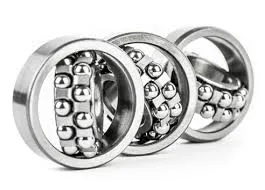
Dec . 16, 2024 15:06 Back to list
Understanding the Functionality and Applications of Thrust Ball Bearings in Machinery
Understanding Thrust Ball Bearings An Overview
Thrust ball bearings are a crucial component in various machinery and mechanical systems, designed to support axial loads while allowing rotational motion. These specialized bearings are unique in their construction and functionality, making them essential in applications where axial force needs to be managed efficiently. This article delves into the design, application, advantages, and maintenance of thrust ball bearings, providing a comprehensive overview of their significance in engineering.
Design and Construction
Thrust ball bearings consist of two raceways and a set of balls situated between them. The design allows the bearing to handle axial thrust but not radial loads, which distinguishes it from other types of ball bearings like deep groove or angular contact bearings. Typically, these bearings are constructed from high-quality materials such as chrome steel or stainless steel, which contribute to their durability and performance.
The basic structure includes an inner ring, an outer ring, and a set of balls. The inner ring rotates together with the shaft, while the outer ring remains stationary. This configuration minimizes friction and wear, enabling smooth rotation under substantial axial force. Thrust ball bearings come in simple designs, but there are also variations, including single and double direction bearings, which can accommodate loads in both axial directions.
Applications
Thrust ball bearings find applications in a wide range of industries. They are commonly used in automotive components, such as clutches and gearboxes, as well as in heavy machinery, aerospace equipment, and industrial machinery. In electric motors, thrust ball bearings play a critical role in ensuring that the rotor operates smoothly under axial loads.
Moreover, these bearings are also utilized in household appliances like washing machines and vacuum cleaners, where managing axial loads is essential for efficient operation. Additionally, thrust ball bearings are essential in robotics and automation systems, where precise control and stability are necessary for performance.
Advantages
thrust ball bearings pdf

One of the primary advantages of thrust ball bearings is their ability to handle significant axial loads while maintaining low friction. This characteristic leads to increased efficiency and reduced energy consumption in mechanical operations. Furthermore, the simplicity of their design translates to easier installation and maintenance, making them a preferred choice for many engineers.
Thrust ball bearings also exhibit high resistance to wear and tear, extending their operational lifespan. This durability is particularly beneficial in demanding environments where bearings are exposed to heavy loads and potential contaminants. Additionally, the smooth rotational capability they provide translates to enhanced performance for the overall machinery.
Maintenance Tips
To ensure longevity and optimal performance of thrust ball bearings, regular maintenance is crucial. Routine inspections can identify signs of wear, contamination, or misalignment, allowing for timely interventions. Keeping the bearings well-lubricated is also vital; appropriate lubrication minimizes friction and heat buildup, which can lead to premature failure.
It's important to select the right grease or lubricant based on the application requirements. High-temperature environments may require special lubricants, while corrosive conditions might necessitate the use of sealed bearings to protect against moisture and debris.
Furthermore, maintaining proper installation procedures is essential for preventing premature failure. Ensuring that the bearings are aligned correctly and that mating surfaces are clean will help in achieving optimal performance.
Conclusion
In summary, thrust ball bearings are indispensable components in various mechanical systems, offering effective solutions for managing axial loads. Their robust design, coupled with their ability to enhance efficiency and longevity, makes them a cornerstone in engineering applications. Whether in industrial machinery, automotive components, or household devices, understanding and properly maintaining thrust ball bearings is key to their successful operation and the machinery they support.
Latest news
-
Premium Deep Groove Ball Bearings | High Speed & Reliability
NewsAug.29,2025
-
Durable Scaffolding Clamps - Secure & Reliable Tube Connectors
NewsAug.28,2025
-
Common Failures in Thrust Ball Bearings and Solutions
NewsAug.22,2025
-
How Tapered Roller Bearings Can Take Shock Loads
NewsAug.22,2025
-
Angular Bearings in High-Precision Spindles
NewsAug.22,2025
-
The Impact of Misalignment on Cylindrical Roller Bearing Performance
NewsAug.22,2025
